Today Winterlude’s crew decides for fun (after skiing) we’ll pretend to be the TV Show “MythBusters”! My AARP Magazine tells me mixing baking soda and lemon juice is a great substitute for expensive brass polish. Hmmm… always on the lookout for everyday cleaning ingredients that are already aboard, rather than having to buy special stuff for special purposes, I run for the tarnished brass bell and my baking soda and lemon juice. To make it an easy comparison, I decide to test the concept against Brasso, the brass cleaner we happened to have on hand.

Step 1. The wannabee volcano … remember when you used to mix vinegar and baking soda and the volcano erupted? When I mixed the baking soda and lemon juice I got a mini-reaction, nothing like the eruption, but definite bubbling. I put about a quarter inch of lemon juice in a tiny bowl and added baking soda until I mixed a thick liquidy paste.

Step 2. Now we wanted to find out how much work this method of polishing the brass bell would entail – after all, we’re all for as little hard labor as possible! I put a small amount of the paste on a clean but trashed t-shirt and started massaging it into a small stripe on the bell. Voila! It IS getting brighter. Applying a bit of pressure, I added more paste until I “massaged” the strip for a couple of minutes, maybe. I kept getting more and more black on my rag.
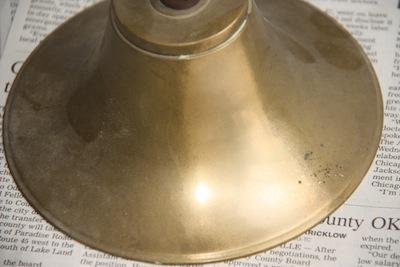
Step 3. After 2-3 minutes, I wiped it clean and took a photo. Not bad. Not great shiny, but not bad. So I took a photo.
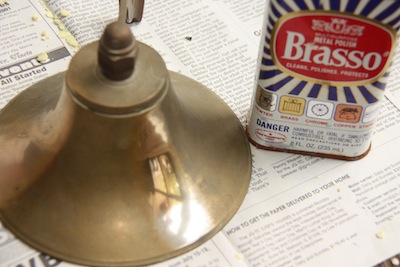
Step 4. Now comes the comparison — we put a bit of Brasso on another clean but trashed section of t-shirt and took a swipe so make the bell appear to be striped. Oops, with substantially less work, the Brasso made a strip of bright shiny polished brass – so much so that I had to change the angle of photo because my reflection kept appearing in the stripe. 🙁 If we were MythBusters, we’d say BUSTED!
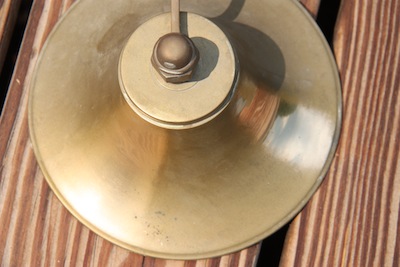
But wait, there’s more! David commented that he smelled ammonia in the Brasso. Sure enough, we read the ingredients and ammonia is the 2nd listed ingredient in Brasso. Hmmm…. ammonia is one of the common cleaners always aboard Winterlude.
Wonder if we’d blow up the world if we mixed AMMONIA and baking soda instead of the lemon juice.

First of all, no explosive reaction … not even much bubbling, much to our chagrin. 🙁 How can this be the next greatest discovery ever if it doesn’t even bubble? Second after spending about an equal amount of time massaging the Ammonia and Baking Soda Mixture into the tarnished brass, we had a little less satisfactory clean than the Lemon Juice and Baking Soda Mixture. Although in a pinch, I guess you could use it. I probably wouldn’t. Before I caught David, he had already polished half our bell with Brasso, so the shiny side is the other side. The “scratch” in the ammonia side isn’t a scratch, it’s baking soda not sufficiently polished off.

Oh well, all great inventions take several flops before succeeding, so we’re back to trying to figure out something else to make commuter cruisers lives easier! In the meantime, David informs me that he intends to use the Lemon Juice & Baking Soda combination on Winterlude’s exterior brass portholes – they’re currently green and we’ve decided we like green given the amount of work required to make them anything but green. 🙂
We’ll see this fall when we return to the boat!
So do you use any common household cleaners to polish brass? Anything exceptionally available, inexpensive and easy? Leave a comment and share the information! Cheers! Jan
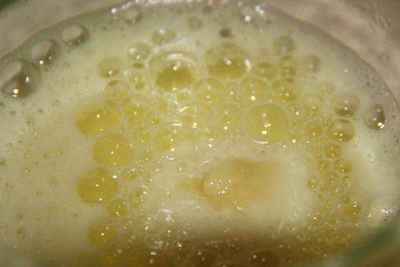
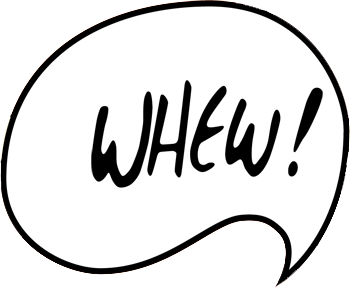
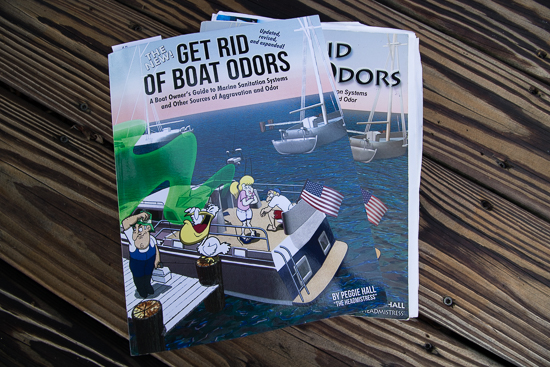










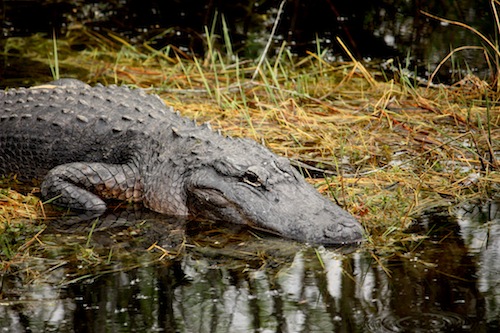
Why polish brass? The green coloration is verdigris, which makes antiques more expensive. ;>) And gives the Statue of Liberty its color.
Our portholes agree with you … and in the 11 years we’ve owned the boat, we haven’t mustered the energy to try and change them. But I do like my lantern down below to shine…
Okay, very well, I would agree with those facts you tossed out but some people would rather have their brass as beautiful and shiny as the day they bought it. It can increase the value of some antiques but honestly that would be one hell of a polish job to try and keep the statue of liberty gleaming or I bet they would have. Imagine the sun or the moonlight beaming off that old lady. So that’s why people would polish their brass. If that icky green is so wonderful to look at then why don’t they sell it like that instead of this shiny appearance that tends to grab your attention pretty quickly. Hmmmm.
Yes it is vedgris and yes the statue of liberty is green because of it. But the statue is bronze not brass. Verdegris eats metal eventually and can leave a pitted surface. If you are happy with green stay happy with it as leaving it for years and then removing it will means a surface that will never be smooth or 100% polishable to a shine.
On bronze verdegris can be a thing called bronze disease and this can eat bronze really quickly. Generally found on things in the ground and I think it is to do with chlorine in the soil but sea spray can do the same.
Yeah Brasso USED to polish and shine like that when it came in a tin can; however, I believe they left that fantastic polishing ingredient out of the mix when they started packaging in plastic container. It DOES NOT EVEN COME CLOSE TO THE OLD BRASSO IN TIN CAN. I hate when that happens.VERY DISAPPOINTED
Brasso used to contain Oxalic Acid, and that’s why it used to clean so well (speaking as a former US Marine that’s polished more brass than Equador has banana trees). Brasso, Flitz, Glit, etc. (various names for that wonderfully stinky cotton ball stuck in a metal can), used a mix (in the old days) of isopropyl alcohol, silica powder, oxalic acid and a couple of other items, such as a now-prohibited solvent that EPA says is a bad-boy.
In reality, you can get a ‘close, but not there yet’ polish on by going on a quick run to the hardware store and fruit stand. You need lemons (or white vinegar), isopropyl alcohol (rubbing alcohol at 90%), powdered buffing compound or powdered silica, and if you can’t find some oxalic acid you can make do with some boric acid (aka ant-killer powder – just read the label for 100% boric acid). Oh yeah, keep in mind, the Brasso that everyone LOVED did NOT use a base chemical (like wood ash or baking soda), it used SILICA (sand) powder for an abrasive ONLY! Everyone’s first mistake is taking a pH of 3 lemon juice and adding a pH of 11 baking soda, and thinking they are doing anything. THEY ARE NOT. AT relatively equal volumes, you are CANCELLING THE pH and making ‘gritty water’, and thus, your elbow grease is all that is really cleaning. (If this is what you want, just use toothpaste, it is SO MUCH EASIER).
Now, mix up your chemicals on the list above with about 15% alcohol, 50-percent silica powder, 3-5 percent boric acid, 5-7 percent white vinegar. This only amounts to 75%, and is where the original BRASSO recipe is hard to duplicate. The original formula now added an ‘organic solvent’ (aka something akin to a naptha or napthalene petroleum) to cut ‘gunk’. I guess you could use naptha or other dangerous chemical, but a smart person would finish this list out with something like a 50/50 cut mix of water-and-Simple Green.
I personally just leave the solvent out, and get a ‘can’t hardly tell the difference’ look. I’m not killing my acid pH to clean my brass, either. Then again, the last few times I’ve cleaned brass, I went with the ‘electrolysis method’ of cleaning instead. Simply put an aluminum plate in the bottom of a deep fryer boiler, add water and baking soda, and bring to a boil before putting my brass in. The ‘electrolysis’ effect (brass sitting on aluminum in an electrolyte touching a steel container) causes the tarnish to absolutely melt away, SAFELY, in quick time.
Either way – Brasso isn’t around anymore, but Flitz (can be found in most Gun Shops for reloading ammunition), Glit (the renamed Brasso), and other cleaners are still relatively cheap unless you are just determined not to go to Walgreens for some unknown reason.
Can I use baking soda and vineger instead of lemon juice
can any sustitute is against brasso . As we have to clean the brass metal .
Wow. Wonderful ideas. It has more useful information. It will help me. Thanks for sharing.